Counties of Maine
Click county name to visit individual website
Franklin
------------------------------------------------------------------------
United States Small Business Administration
WHY Consider an SBA Disaster Loan?
Deadline: April 1 (physical damage to homes, personal property, businesses & non-profits);
October 30 (working capital loans for small businesses)
- The SBA can provide low-interest, long-term loans to homeowners, renters, businesses of all sizes, and non-profits to cover damage incurred December 17-21, 2023, that is not covered by insurance or another source. This disaster declaration includes the counties of Androscoggin, Franklin, Kennebec, Oxford and Somerset.
- No cost to apply. No prepayment penalties.
- No interest or payments for the first year of the loan. If you pay off your SBA loan in less than a year = no interest.
- If offered a loan, you have 2 months to decide whether or not you want to accept it. Apply now, before April 1st. Decide later. You can decline the loan offer at no cost to you.
- Loan terms can be up to 30 years, with relatively small payments. (For example, a $24,000 loan with a 30-year term would have payments of a little over $70 per month. Very affordable.)
- Interest rate: 4% for most businesses, and 2.688% for most homeowners and renters, and 3.25% for non-profits--much cheaper than credit card or other source to cover repairs or operating expenses.
- Even if you already made repairs using a credit card or bank loan (or savings), you can replace that more expensive debt with a low-interest SBA disaster loan.
- SBA disaster loans can also be used to cover an insurance deductible, and one can request an additional 20% of total estimated damage to be used for mitigation to prevent future damage. (sump pump, retaining wall, elevation of furnace & water heater, safe room, stronger shingles, etc.).
- Homeowners can borrow up to $500,000 for damage to their home.
- Homeowners and Renters can borrow up to $100,000 for personal property damage (contents of home).
- Businesses and non-profits can borrow up to $2 million, for physical damage (including equipment, inventory, etc.) and/or economic injury.
- Even if a business owner does not have physical damage, they can still borrow money to provide working capital, if they had a significant drop in sales (economic injury) as a result of the disaster.
- If waiting for an insurance settlement, a business or homeowner can get an SBA loan to allow them to start repairing damage and replacing inventory or personal property, and once the insurance money arrives, it is used to pay off the loan. Thus, it can be used as a bridge loan while waiting for insurance, and if paid off in less than a year, there is no interest to pay.
- For homeowners and renters with damage, it is important for everyone to register with FEMA first, for possible grant assistance. FEMA focuses on ensuring everyone has a safe and secure place to live. This may include temporary rental assistance if the home is not habitable/safe to live in. Assistance for personal property (the contents of the home) is prioritized for those most in need. After registering with FEMA, those above a certain income level may receive a letter saying they have been referred to the SBA. FEMA may still help with temporary housing and basic repairs if the home is not habitable. However, if someone is referred to the SBA, it is very important for the person to follow through and apply for a loan, even if they do not want one. If the loan is denied, they may be referred back to FEMA for possible additional grant assistance for personal property, including cars. And if your no-cost SBA loan application is approved, you have 2 months to decide whether you want or need it. You can decline the loan offer at no cost to you.
(Apply now, before April 1st deadline. Decide later.)
- If a homeowner or renter gets that referral letter after registering with FEMA and doesn’t do anything else, they lose the possibility of getting additional federal assistance for personal property damage
- If your private road/driveway was washed out by the flooding and an emergency vehicle cannot reach your primary residence (where you live over half the year), then you should register with FEMA and include “lack of access” under home damage. FEMA may be able to provide limited assistance, and an SBA disaster loan can cover whatever is not covered by insurance or FEMA.
- Follow up on any denial notices, visit a Disaster Recovery Center, and find out what additional information is needed.
3 WAYS TO APPLY:
1. Apply online or download application at: https://sba.gov/disaster
2. Call or email SBA to request application or learn more: 800-659-2955 or disastercustomerservice@sba.gov
3. Visit a Recovery Center in person to apply, check status, ask questions, and/or speak with FEMA.
Disaster Recovery Center locations (with SBA & FEMA). You can visit any location.
- Androscoggin County: Lewiston Armory, 65 Central Ave., Lewiston, ME; Monday - Saturday, 9am to 5pm (1st Floor, far right corner)
- Oxford County: Rumford Municipal Building, 145 Congress St., Rumford, ME; Monday - Saturday, 9am to 5pm (2nd Floor)
- Kennebec County: Farmingdale Fire Department, 571 ME-27, Farmingdale, ME; Monday - Saturday, 9am to 5pm
- Somerset County: Somerset County EOC, 4 County Dr., Skowhegan, ME; Monday - Saturday, 9am to 5pm
- Franklin County: Roberts Learning Center, 270 Main St., Farmington, ME; Monday - Saturday, 9am to 5pm
Forms
SBA - Disaster Loans for Homeowners and Renters
SBA - Disaster Loans for Businesses and Non-Profits
SBA - Economic Injury Disaster Loans for Businesses and Non-Profits
